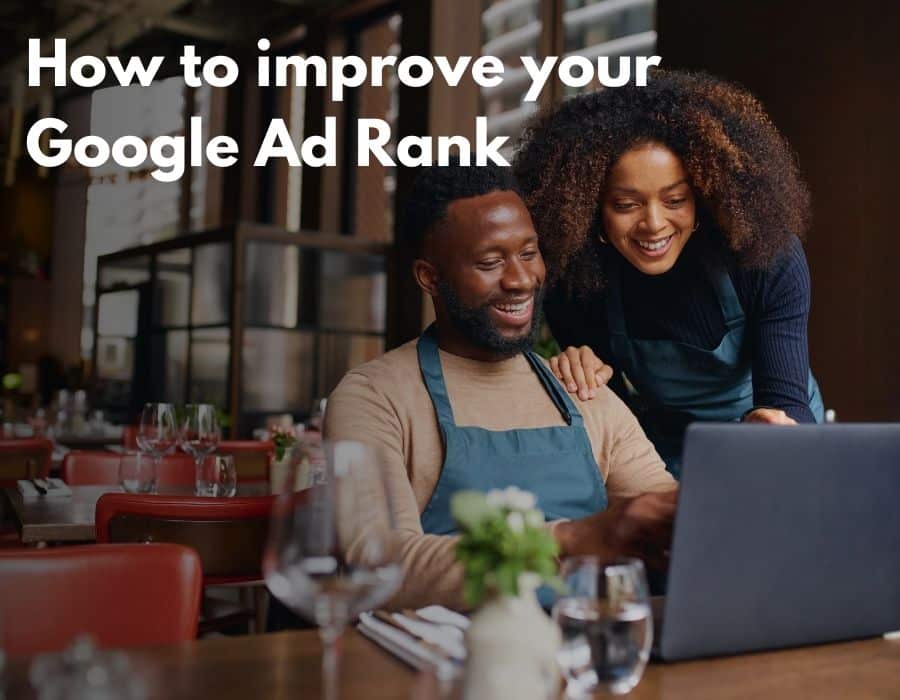Understanding the Google Ad Rank concept
Understanding the Google Ad Rank concept is essential for anyone involved in online advertising. The Ad Rank determines the position of an ad on the search engine results page, and it’s not solely based on the highest bid. Although bids play a crucial role, Google also considers the quality of your ad and landing page, as well as the relevance to the search context. This means that even if you have a high bid, if your ad and landing page don’t provide a good user experience or are not relevant to the search query, your Ad Rank may suffer.
Many advertisers mistakenly focus solely on increasing their bids to improve their ad position, but neglecting other factors can result in wasted budget and lower conversion rates. A holistic approach that takes into account bid strategy, optimizing landing pages for better user experience, and aligning ad content with search intent is crucial for achieving better Ad Ranks. By understanding this concept and striving for a balance between bid amount, landing page quality, and relevance to search context, advertisers can maximize their results while efficiently utilizing their advertising budget.
Importance of Ad Rank
The importance of Ad Rank in the digital advertising landscape cannot be understated. As search engines continue to refine their algorithms, understanding the factors that contribute to Ad Rank becomes crucial for advertisers looking to maximize the impact of their campaigns. While a high Ad Rank doesn’t guarantee success, it significantly increases the visibility and potential reach of an ad, ultimately leading to more clicks, higher CTRs, and potentially more conversions.
It’s essential to recognize that Ad Rank is not solely determined by bid amount. Factors such as ad relevance, landing page experience, and expected CTR play a pivotal role in determining the position and prominence of ads. This highlights the need for a holistic approach to campaign optimization, focusing on improving ad quality scores and relevancy rather than just increasing bids. By aligning with user intent and delivering valuable content through targeted ads, advertisers can positively impact their Ad Rank while simultaneously driving higher conversions. Understanding these dynamics can give advertisers a competitive edge in maximizing their ROI and achieving their digital marketing objectives. You can see an example below on how ad ranking affects your performance of your ads
| Ad Rank | Impr. on absolute top | Impr. on top | Impr. (Abs top) % | Impr. (top) % | |
|---|---|---|---|---|---|
| Advertiser 1 | 80 | 1 | 1 | 100% | 100% |
| Advertiser 2 | 50 | 0 | 1 | 0% | 100% |
| Advertiser 3 | 30 | 0 | 0 | 0% | 0% |
| Advertiser 4 | 10 | 0 | 0 | 0% | 0% |
In conclusion, as digital advertising becomes increasingly competitive, having a strong understanding of Ad Rank’s significance is paramount for any advertiser striving to stand out in the online marketplace. By prioritizing factors like ad relevancy, CTR optimization strategies, and enhancing landing page experiences alongside bid management tactics – marketers can pave the way towards improved ad positions which can lead to higher conversion rates. Ultimately leveraging these insights will enable businesses to thrive in an intensely competitive digital advertising landscape.
Optimizing Quality Score
Optimizing Quality Score is crucial for businesses aiming to improve their online advertising performance. One effective approach is to focus on creating relevant and compelling ad copy that aligns with the keywords and landing pages. By ensuring a high degree of relevance, you can positively impact your Quality Score, leading to improved ad rankings and lower costs per click.
Furthermore, consistent monitoring and refining of keyword selection are essential elements in the pursuit of a higher Quality Score. Utilizing negative keywords strategically to filter out irrelevant traffic can refine ad targeting effectively, resulting in more qualified leads and better conversion rates. Finally, it’s important to emphasize the user experience by optimizing landing page quality – this involves ensuring fast loading times, mobile responsiveness, engaging content, and clear calls-to-action. Prioritizing these aspects not only pleases users but also contributes significantly to boosting Quality Scores.
In conclusion, an emphasis on relevance across all facets of online advertising is key to optimizing Quality Score. By continuously evaluating and perfecting ad copy, keywords selection, and landing page experiences, businesses can successfully enhance their overall digital marketing performance while simultaneously reducing costs associated with paid search campaigns.
Ways To Optimize Your Quality Score

Managing Your Bid Strategy
Effective bid strategy management is crucial for improving ad rank and maximizing the visibility of your ads. One key aspect to consider is aligning your bids with your quality score. While high bids can increase ad rank, they may not be sustainable if your quality score is low. By focusing on improving the relevance and quality of your ads, you can lower the cost-per-click while maintaining or even increasing ad position.
Another important consideration is leveraging automated bidding strategies offered by platforms like Google Ads. These tools allow you to set specific goals, such as maximizing clicks or optimizing for conversions, and can adjust bids in real-time based on various factors. By adopting a data-driven approach and relying on these advanced features, advertisers can achieve more efficient bid management and ultimately improve ad rank without constantly monitoring and adjusting their bids manually.
Furthermore, taking advantage of advanced targeting options, such as time of day or device targeting, can help optimize bid strategy for better ad placement. By analyzing performance data to identify when and where your ads perform best, you can allocate budgets more effectively to reach the right audience at the right time—ultimately boosting ad rank through strategic bidding decisions aligned with user behavior.
Search Context
The context of a person’s search plays a pivotal role in determining the ad rank within the competitive digital advertising landscape. Location, for instance, significantly influences the relevance of ads to users. A user searching for best pizza places in New York will likely see different results than someone searching for the same thing in Los Angeles. This locality factor is crucial, as advertisers must tailor their strategies to target specific geographic regions effectively.
Furthermore, the type of device used impacts how ads are ranked. Mobile users may encounter different ad placements and formats compared to those using desktops or tablets. As such, advertisers must optimize their ads to cater to these distinct devices and user behaviors. Additionally, the nature of the search can greatly influence ad ranking. For instance, a highly specific long-tail search query may yield more targeted and relevant ads compared to broader keyword searches.
Overall, understanding and leveraging contextual factors such as location, device type, and search intent are essential for advertisers looking to maximize their ad rank performance across various platforms and channels. By considering these elements strategically, advertisers can enhance targeting precision and ensure that their messages resonate with audiences in diverse contexts.
Ad Assets Impact On Ad Rank
When it comes to ad ranking on digital platforms, the impact of ad assets come in at one of the top positions in terms of importance. Images play a crucial role in capturing the attention of users and conveying a message before they even read the headline. An eye-catching image or headline can significantly boost click-through rates and engagement, positively influencing ad rank.
In addition, compelling headlines are essential for drawing in potential customers. A strong headline not only improves the effectiveness of an ad but also contributes to its overall relevance and quality score, both important factors in determining ad rank. Similarly, including relevant site links can enhance user experience by providing easy access to additional information or specific landing pages, ultimately improving ad performance.
Overall, it’s clear that each element of an ad asset plays a pivotal role in shaping ad rank. By optimizing images, headlines, and site links effectively, advertisers can positively influence their position in search results and increase the likelihood of capturing audience attention and driving conversions.
Ad Competitiveness
The competitiveness of an auction in the online advertising world is akin to a high-stakes game of strategy and wits. With each advertiser vying for prime ad placement, the pressure is on to craft compelling headlines and captivating images that will draw clicks and engagement. In this fast-paced arena, every aspect of an ad contributes to its success or failure, making it essential to optimize cost-per-click and ad rank for maximum impact.
Site links play a crucial role in boosting the visibility and performance of an ad within the auction environment. As competing advertisers strive to outshine one another, leveraging site links effectively can make a significant difference in engaging users and driving conversions. This dynamic landscape demands continuous innovation and adaptation, as staying ahead requires more than just bidding higher – it involves a deep understanding of audience behavior, market trends, and evolving advertising technologies.
Landing Page Experience
When it comes to the success of a landing page, the ad rank score plays a crucial role in determining its visibility. The higher the ad rank score, the greater the chance of capturing user attention. However, beyond just driving traffic to the landing page, seamless navigation is equally essential for optimizing user experience. With intuitive and responsive navigation, visitors can effortlessly explore the content and find what they are looking for, leading to greater engagement and conversion rates.
Moreover, while visually appealing design may initially attract visitors, it is ultimately the quality of content that determines their stay and interaction. Compelling and relevant content not only keeps visitors engaged but also influences their decision-making process. By prioritizing engaging and informative content on a landing page, businesses can create a more impactful user experience that resonates with their audience. In essence, balancing ad rank scores with seamless navigation and quality content is key to crafting an irresistible landing page experience that captivates visitors from their first click.
Expected Click-Through Rate
The expected click-through rate is a crucial predictive metric that influences ad rank and ultimately, the success of digital marketing campaigns. However, accurately estimating this rate is complex due to evolving consumer behavior and the increasing competition for online attention. One approach to enhancing predictions is to leverage data-driven insights into audience preferences and behavior, enabling marketers to tailor their messaging and creative assets for maximum impact.
On the other hand, it’s essential to recognize that variables such as ad placement and targeting also play pivotal roles in determining click-through rates. An ad’s prominence on a webpage or social media platform can significantly influence user interaction. Similarly, precise targeting based on demographic data, interests, and browsing history can vastly improve the probability of generating clicks. Therefore, understanding these nuances is critical for marketers looking to optimize their campaigns and drive meaningful results.
Ad Relevance
Ad relevance is a pivotal measure of how well an ad matches what the user is searching for. In today’s saturated digital environment, capturing audience attention has become increasingly competitive. The key lies in understanding the nuanced art of ad relevance and its impact on successful marketing strategies. With the continual evolution of search algorithms and user behavior, staying abreast with ad relevance is crucial to maintaining an edge in the dynamic digital landscape.
At its core, ad relevance not only determines the efficacy of an advertisement but also shapes users’ online experiences. By delivering ads that directly align with user intent and interests, businesses can foster deeper connections with their target audience. This approach not only enhances brand visibility but also cultivates trust and credibility among consumers. As such, optimizing ad relevance isn’t just a matter of reaching the right people at the right time but it’s about delivering meaningful and personalized content that resonates with individuals on a deeper level.
Next Steps To Optimizing Your Google Ad Rank Scores
Once you’ve made improvements to your landing page and created new ad assets, it’s essential to re-evaluate your bid strategy for Google Ad Rank optimization. While these foundational elements are crucial, refining your bidding approach can further propel your ad rank scores to new heights. One effective strategy is to leverage automated bidding tools offered by Google Ads, such as Target ROAS or Maximize Conversions. These tools use machine learning to optimize your bids based on specific performance targets, allowing you to maximize the impact of your budget and improve ad rank.
In addition to automated bidding, consider implementing ad schedule bid adjustments to optimize for peak performance times. By analyzing data on when your target audience is most active and adjusting bids accordingly, you can ensure that your ads are prominently displayed during key moments. This nuanced approach not only enhances ad visibility but also maximizes the effectiveness of your budget allocation. Taking these next steps in bid strategy optimization will undoubtedly elevate your Google Ad Rank scores and drive better results for your campaigns.






